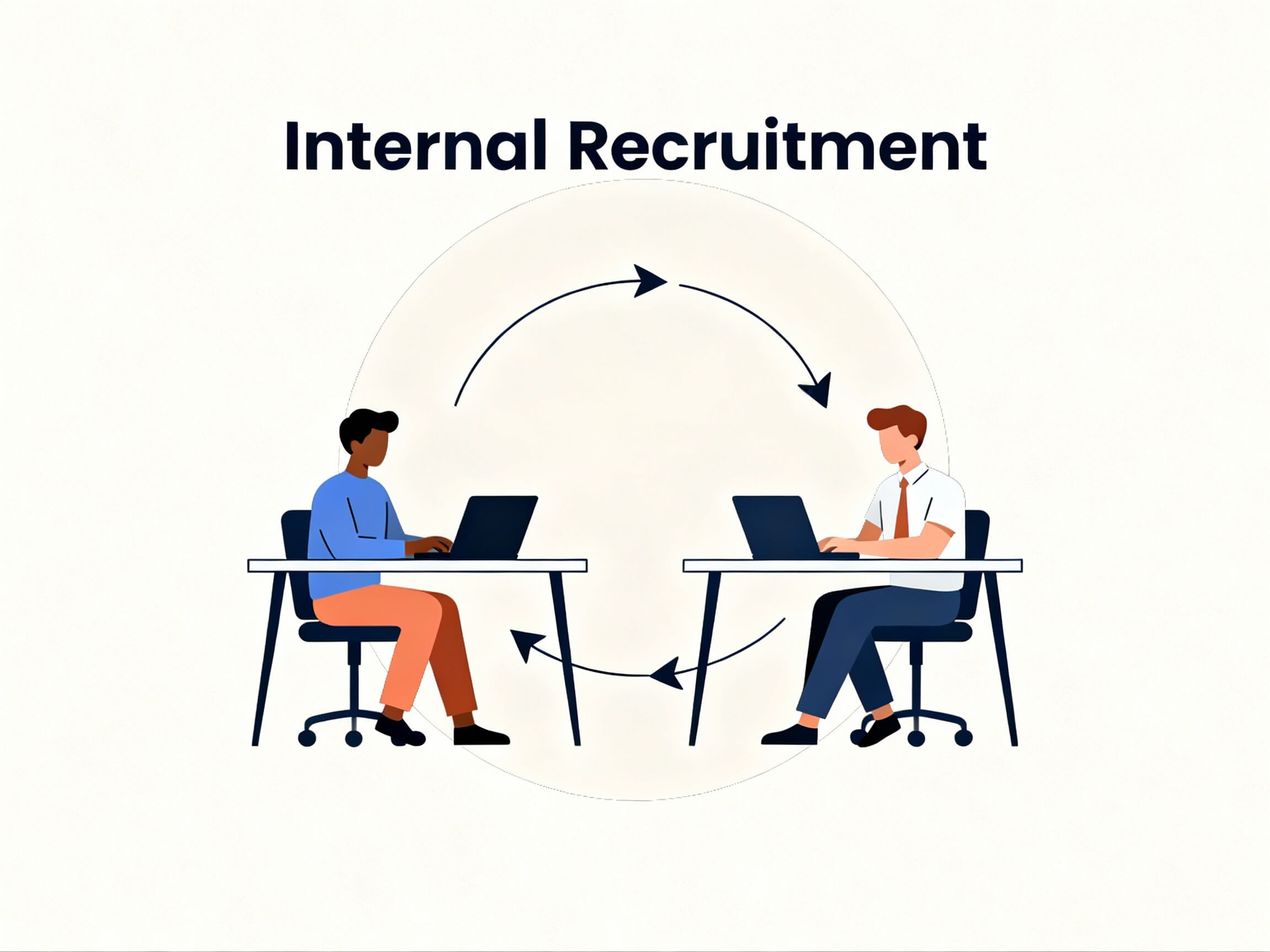Should you promote from within the company or hire external candidates? Each approach offers distinct advantages. Hiring internally cuts costs and speeds up onboarding, while external recruitment brings specialized skills and fresh perspectives. In this guide, we compare both approaches across cost, timeline, risk factors, and practical scenarios. You’ll learn when to use each and how to make the right choice for your remote IT team from Europe. 👇
How recruiting internally works
What is internal recruiting?
Internal recruitment means filling open positions with current employees. You promote existing team members or transfer them to new roles within your company rather than hiring outside candidates.
For example, your current software developer becomes a team lead, or a QA engineer transitions to a DevOps role.

Advantages of hiring internally
Benefits of internal recruitment include
- Lower costs.
- Faster time-to-productivity.
- Higher retention rates.
- Known performance history.
- Boosted employee morale. 👇
Lower costs
Hiring an internal candidate is often less expensive than hiring an external one. You skip agency commissions, job advertising fees, and the higher salary premiums typically required to attract outside talent.
Faster time-to-productivity
Current employees already understand your systems, processes, and culture. They reach full productivity in weeks, compared to 3–6 months for external hires.
Higher retention rates
Employees who move internally are 40% more likely to stay for at least three years. They see clear career progression and feel valued.
Known performance history
You’ve seen your current employees’ work quality, collaboration skills, and problem-solving abilities. This removes the uncertainty that comes with external candidates.
Boosted employee morale
Internal promotion opportunities motivate your entire team. Employees work harder when they see there is room to grow.
Disadvantages of internal recruitment
The drawbacks of internal recruitment are:
- Limited skill diversity.
- New vacancies.
- Potential workplace tension.
- Status quo thinking.
- Smaller candidate pool. 👇
Limited skill diversity
Your internal talent pool may lack specialized expertise. Finding a Rust developer or ML engineer proves difficult when your team works primarily with JavaScript.
New vacancies
Promoting one employee leaves their previous position empty. You shift the hiring problem rather than solve it.
Potential workplace tension
Multiple internal candidates competing for one role can damage relationships. The unsuccessful candidates may feel resentment.
Status quo thinking
Internal hires bring the same perspectives your team already has. You miss out on fresh approaches and innovative ideas.
Smaller candidate pool
You choose from a dozen internal employees rather than a hundred external candidates. Your chances of finding the perfect fit drop significantly.
External recruiting explained
What is external recruitment?
External recruiting is hiring candidates who don’t currently work at your company. You source talent from the European job market or headhunt competitors.
When you post a job opening publicly or just get in touch with outside professionals, you’re recruiting externally.

Advantages of external recruitment
Benefits of external recruitment include:
- Access to specialized skills.
- Fresh perspectives and innovation.
- Larger talent pool.
- No internal politics.
- Competitive intelligence.
- Scaling your team faster. 👇
Access to specialized skills
The EU job market alone has around 10 million IT professionals with diverse expertise. You can find niche specialists your internal team lacks.
Fresh perspectives and innovation
External hires often bring new ideas, different methodologies, and unique problem-solving approaches.
Larger talent pool
There are hundreds or even thousands of candidates, not just a handful. This increases your chances of finding exceptional talent.
No internal politics
People from outside the company enter without existing workplace relationships or biases. They can make objective decisions and challenge outdated practices.
Competitive intelligence
Those hired externally share industry best practices, new technologies, and fresh approaches they learned elsewhere.
Scaling your team faster
You can hire multiple external candidates at the same time. In comparison, when recruiting internally, you’re typically limited to one hire per promotion cycle.
Disadvantages of external recruitment
Drawbacks of external recruitment are:
- Higher costs.
- Longer time-to-hire.
- Cultural fit uncertainty.
- Performance unpredictability.
- Lower initial retention. 👇
Higher costs
External recruitment adds up through job board advertising, agency fees, interview time for HR and hiring managers, and onboarding expenses for new hires.
Longer time-to-hire
In the IT industry, the average time to hire is approximately 58 days (though this can vary depending on the role’s complexity and seniority).
Cultural fit uncertainty
New team members may struggle to adapt to your work environment. 47% of employees reported feeling disconnected from company culture, which often leads to dissatisfaction and higher attrition.
Performance unpredictability
Resumes and interviews don’t always predict actual performance. You take a bigger risk with unknown candidates.
Lower initial retention
Newly hired external employees are 61% more likely to be fired than those internally promoted.
Comparing internal vs external recruitment
| Factor | Internal recruiting | External recruiting |
| Average cost | generally lower | typically higher |
| Time to hire | 2–3 weeks | around 8 weeks |
| Time to full productivity | several weeks | 3–6 months |
| Candidate pool size | dozens | hundreds or thousands |
| Cultural fit risk | low | medium-high |
| Skill specialization | limited | extensive |
| Innovation potential | low | high |
| Employee morale impact | positive | neutral |
Hiring internally vs externally: Which option fits when
When to choose internal recruitment
Results cannot wait
Imagine your product launch is in 4 weeks, and you need a project lead today. An internal promotion gets someone operational immediately.
Budget constraints limit spending
Especially for startups and small companies with tight budgets, internal recruitment can deliver around 25% in cost savings.
Cultural fit matters more than specialized skills
Leadership roles and client-facing positions require a deep understanding of your company’s values and processes.
You have strong internal talent
If your team includes high performers ready for advancement, internal recruitment rewards, and retains them.
The role requires company-specific knowledge
For roles involving proprietary systems, unique workflows, or complex in-house tools, an existing internal employee is likely a better fit.
Cases that call for external recruitment
Specialized technical skills are required
When hiring a blockchain developer, cybersecurity expert, or data scientist, you often need to tap the external market. Internal teams tend to lack these niche skills.
The company is scaling rapidly
Growing from 20 to 100 employees demands external recruitment. You can’t promote fast enough to fill all positions.
You want fresh perspectives
Stagnant innovation signals a need for outside thinking. External hires challenge assumptions and bring new approaches.
Internal candidates lack qualifications
When no current employee meets the role requirements, external recruitment becomes necessary.
Business is entering new markets or technologies
Expanding into new countries or adopting additional tech stacks? This requires expertise your team may not have.
Hybrid approach: Using both internal and external recruitment
Innovative companies don’t choose one method exclusively. They blend both approaches based on specific needs.
Pro tip: Post positions both internally and externally. This maximizes your candidate pool while showing internal employees they have opportunities. Set clear evaluation criteria so internal candidates understand how you assess all applicants fairly.
Use internal recruitment for leadership continuity and external recruitment for specialized technical roles. This balances cultural preservation with skill acquisition.
How to decide between internal vs external recruiting
To make a choice of internal and external recruitment, you need to:
- Assess your timeline.
- Evaluate skill requirements.
- Calculate your budget.
- Try to identify an internal candidate.
- Consider the company growth stage. 👇
Step 1: Assess your timeline
Need someone operational in under 4 weeks? Consider internal candidates first.
Step 2: Evaluate skill requirements
List must-have technical skills. Can your current team fulfill 80% or more? Internal recruitment works. Below 80%? Look externally.
Step 3: Calculate your budget
Budget constraints? Start with internal options. Flexible budget? External recruitment offers more choices.
Step 4: Try to identify an internal candidate
Do you have 2–3 qualified in-house candidates? Proceed with internal recruitment. Fewer than 2? Expand externally.
Step 5: Consider the company growth stage
Early-stage startups benefit from external recruitment to build diverse teams. Mature companies can leverage internal talent more effectively.
Best practices for internal and external recruitment processes
For internal recruiting
- Announce openings company-wide before posting externally.
- Provide clear career development paths.
- Offer training programs to develop the needed skills in-house.
- Give constructive feedback to unsuccessful internal candidates.
- Support managers who encourage team growth over hoarding talent.
For recruiting externally
- Partner with specialized IT recruitment agencies familiar with European markets.
- Leverage professional networks and developer communities.
- Attend European tech conferences and meetups.
- Emphasize “remote-first” in your job postings to access a broader talent pool.
- Implement structured interviews to assess technical and cultural fit objectively.
How DNA325 supports external recruitment in Europe
When you need external tech talent from Europe, DNA325 handles the complete recruitment process:
- Initial candidate selection and phone prescreening interviews, including an English proficiency check.
- Sharing candidate information with you, such as CVs, LinkedIn profiles, prescreening interview reports, and candidate scorecards.
- Scheduling interviews with your participation.
- Communication with candidates throughout all stages of the selection process.
Ready to grow your European IT team with an external recruiter? Reach out to DNA325 to discuss your hiring needs. 👇
FAQs on hiring internally vs externally
Internal recruitment takes 2–3 weeks from posting to start date. External recruitment takes around 8 weeks on average. However, you can speed up the process by working with an agency. For example, at DNA325, the time to fill a position is usually about a month. Still, this can vary depending on how quickly you process applications and schedule interviews.
Yes. Many companies use this hybrid approach to maximize candidate quality. Announce internally first for 5–7 days, then open externally. This shows respect for current employees while accessing the broader market. Set objective criteria so in-house candidates understand that the evaluation process treats everyone equally.
Use an agency when:
• Hiring hard-to-fill IT roles (e.g., DevOps or cybersec).
• Expanding talent search across Europe.
• Lacking an internal recruiter.
• Looking to fill positions quickly.
Agencies provide prescreened candidates and handle initial interviews, so you save significant time.
Communicate the selection criteria clearly before posting the role. Explain what skills and experience the position requires. After selection, provide detailed feedback to unsuccessful internal candidates. Help them understand areas for growth and plan future opportunities.
IT recruitment isn’t limited by country borders. You can consider hiring professionals from different corners of Europe and working with a specialized agency. For example, DNA325 helps source talent from over 20 European countries.
Communicate your hiring strategy openly. Explain when you’ll prioritize internal candidates (leadership, cultural fit roles) versus external recruitment (specialized skills, rapid scaling). Invest in training programs to help your current employees develop skills for future openings. This shows you value in-house growth while acknowledging when outside expertise serves the company better.



